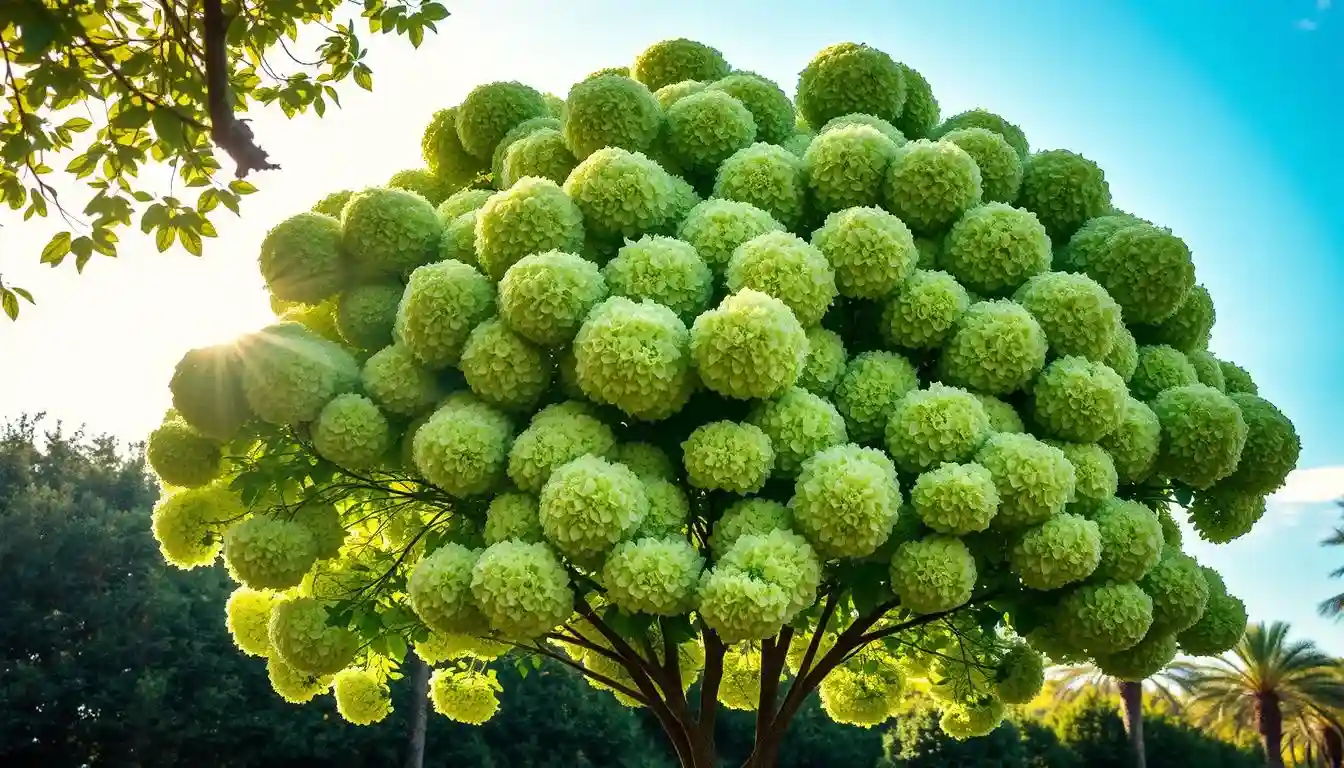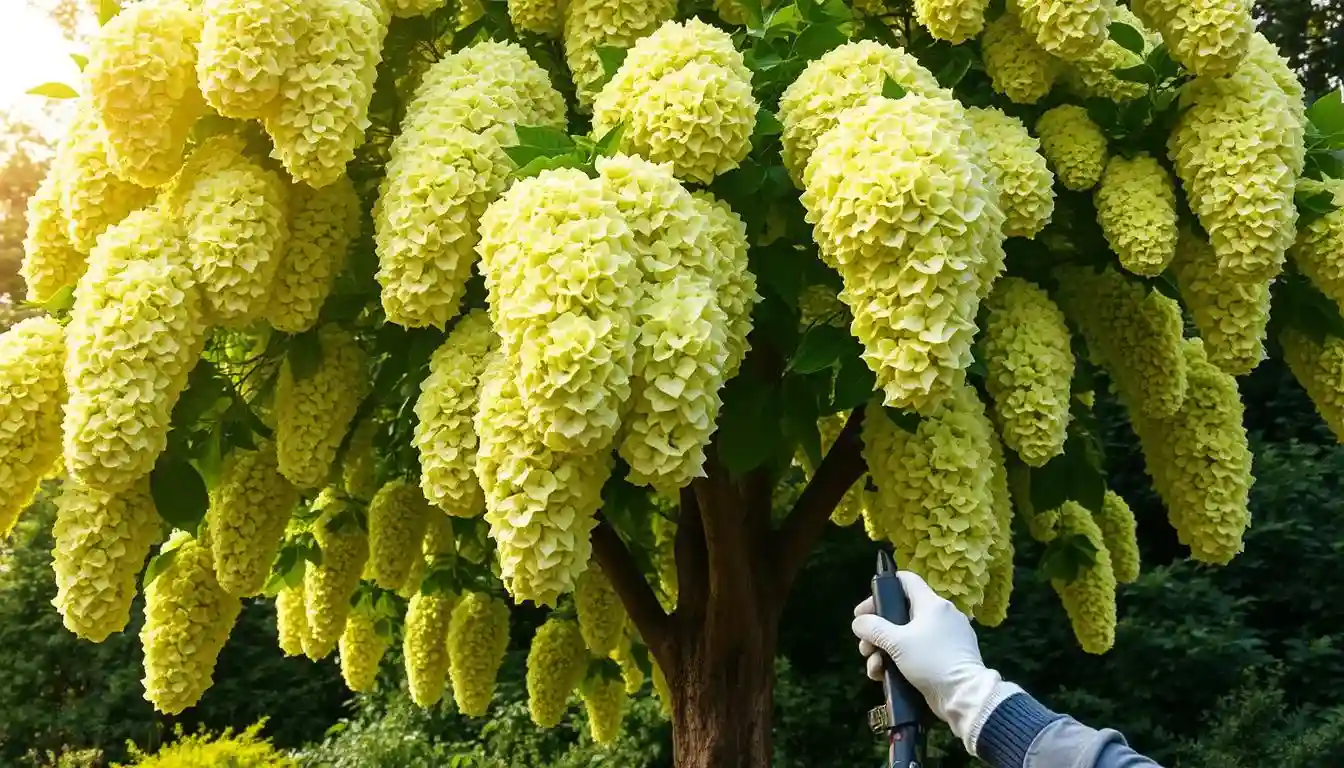Are you looking to add a stunning hydrangea tree to your garden? The Limelight Hydrangea Tree is a popular choice among gardeners due to its beautiful blooms and relatively low maintenance requirements. This tree is known for its vibrant flowers that bloom in the summer, adding a touch of elegance to any outdoor space.
With the right care, your hydrangea tree can thrive and become a focal point in your garden. In this article, we will provide you with a comprehensive growing guide and care tips to ensure that your tree remains healthy and flourishes.
Key Takeaways
- Understand the growing conditions required for a healthy Limelight Hydrangea Tree
- Learn how to care for your hydrangea tree to promote vibrant blooms
- Discover tips on maintaining the overall health of your tree
- Find out how to address common issues that may arise
- Get insights into the benefits of having a Limelight Hydrangea Tree in your garden
What Is a Limelight Hydrangea Tree?
If you’re considering adding a Limelight Hydrangea Tree to your landscape, understanding its characteristics is essential. The Limelight Hydrangea Tree is a versatile and attractive plant that can elevate the beauty of any garden. It is known for its large, vibrant blooms and elegant structure, making it a popular choice among gardeners.
Characteristics and Appearance
The Limelight Hydrangea Tree is characterized by its large, lime-green flowers that bloom in mid-summer and last until fall. These flowers are not only beautiful but also provide a striking contrast to the plant’s dark green leaves. The tree’s upright growth habit and sturdy branches make it an excellent choice for adding structure to your garden.
The Limelight Hydrangea Tree typically grows to be between 6 to 8 feet tall, making it a manageable size for most gardens. Its broad, rounded shape adds to its ornamental value, providing a beautiful silhouette even when it’s not in bloom.
Differences Between Limelight Hydrangea Shrubs and Trees
One of the key differences between Limelight Hydrangea shrubs and trees is their growth habit. While shrubs tend to be more sprawling and require regular pruning to maintain shape, Limelight Hydrangea Trees are trained to grow with a single leader, giving them a more tree-like appearance.
Limelight Hydrangea Trees are also generally more upright and taller than their shrub counterparts, making them ideal for creating a dramatic focal point in your garden. Additionally, their tree form can make them easier to integrate into landscapes with limited space.
How to Plant a Limelight Hydrangea Tree

To ensure your Limelight Hydrangea tree thrives, follow these essential planting steps. Planting a Limelight Hydrangea tree is a straightforward process that requires some basic knowledge about the ideal conditions and care it needs.
Best Time for Planting
The best time to plant a Limelight Hydrangea tree depends on your location. In general, spring or fall are considered the best seasons because they offer mild temperatures and ample moisture. Avoid planting in the peak of summer or winter to minimize stress on the tree.
Ideal Location and Soil Requirements
Limelight Hydrangea trees prefer well-draining soil and a location that receives partial shade to full sun. They can thrive in a variety of soils but prefer a slightly acidic to neutral soil pH (around 6.0-7.0). Ensure the planting area is free from weeds and has good air circulation to prevent disease.
| Soil Condition | Ideal pH Range | Drainage Requirement |
| Slightly Acidic | 6.0-6.5 | Good drainage |
| Neutral | 6.5-7.0 | Well-draining |
Step-by-Step Planting Guide
1. Dig a hole twice as wide and just as deep as the tree’s root ball.
2. Gently remove the tree from its container and place it in the hole, ensuring the root flare is level with the soil surface.
3. Fill the hole with a mix of soil and organic matter, tamping it down gently to remove air pockets.
By following these steps and considering the ideal conditions for your Limelight Hydrangea tree, you’ll be giving it a strong start towards a healthy and vibrant life.
Limelight Hydrangea Tree Care Guide
To keep your Limelight Hydrangea Tree thriving, it’s essential to understand its specific care requirements. Proper care ensures that your tree remains healthy and continues to produce its stunning blooms. By following a few simple guidelines, you can enjoy the beauty of your Limelight Hydrangea Tree throughout the growing season.
Watering Needs
Your Limelight Hydrangea Tree needs consistent moisture, especially during its first year of growth. Water it deeply once or twice a week, depending on weather conditions. Ensure the soil drains well to prevent waterlogged soil, which can lead to root rot.
Fertilizing Schedule
Fertilizing your Limelight Hydrangea Tree is crucial for promoting healthy growth and abundant blooms. Apply a balanced, slow-release fertilizer in early spring, following the manufacturer’s instructions. Avoid over-fertilizing, as this can damage the tree.
Seasonal Care Tips
Caring for your Limelight Hydrangea Tree varies by season. Here are some tips to keep in mind:
Spring Care
In spring, remove any dead or damaged branches to promote healthy growth and improve air circulation.
Summer Maintenance
During summer, ensure your tree receives adequate water and mulch around the base to retain moisture and suppress weeds.
Fall Preparation
In fall, prepare your Limelight Hydrangea Tree for the next growing season by applying a layer of compost or well-rotted manure around the base.
Pruning Your Limelight Hydrangea Tree

The art of pruning can make a significant difference in the overall appearance and health of your Limelight Hydrangea Tree. Proper pruning techniques help maintain the tree’s shape, promote healthy growth, and encourage blooming.
When to Prune
The best time to prune your Limelight Hydrangea Tree is in late winter or early spring, before new growth begins. This timing allows you to remove dead branches and shape the tree before the growing season starts. Avoid pruning in fall, as it can stimulate new growth that may not have time to harden off before winter.
Pruning Techniques
To prune your Limelight Hydrangea Tree effectively, you’ll need a few basic tools: sharp pruning shears, loppers, and a pruning saw. Start by removing any dead, diseased, or damaged branches. Then, cut back branches that are crossing or rubbing against each other. Use the following steps:
- Remove any weak or spindly growth.
- Cut back branches to the desired shape.
- Make clean cuts just above a bud or lateral branch.
Regular pruning not only keeps your Limelight Hydrangea Tree looking its best but also promotes healthy growth and blooming. To maintain the tree’s shape, prune it annually, removing any branches that are growing outside of the desired shape. You can also use pruning to encourage more blooms by cutting back old wood.
By following these pruning techniques and tips, you’ll be able to keep your Limelight Hydrangea Tree healthy, thriving, and looking its best.
Landscaping with Limelight Hydrangea Trees
Incorporating limelight hydrangea trees into your landscape can elevate its beauty and create a stunning focal point. These trees are known for their vibrant blooms and versatility in garden design.
Design Ideas and Placement
When planning your landscape, consider placing limelight hydrangea trees in a location that highlights their beautiful flowers. They can be used as a specimen tree or as part of a mixed border. Ensure they receive adequate sunlight and are planted in well-draining soil.
- Use limelight hydrangea trees as a centerpiece in your garden.
- Pair them with other flowering shrubs for a vibrant display.
- Consider their mature size when planning your landscape.
Companion Plants
Choosing the right companion plants can enhance the beauty of your limelight hydrangea trees. Consider plants that complement their bloom times and growing conditions.
- Hostas and ferns provide a lush, green backdrop.
- Daylilies and coneflowers add color and texture.
- Boxwood or holly can be used for formal hedges or borders.
Comparison with Other Hydrangea Varieties
Limelight hydrangea trees are just one of many beautiful hydrangea varieties. Comparing them with other types can help you decide which is best for your garden.
Vanilla Strawberry Hydrangea Tree
The vanilla strawberry hydrangea tree is known for its cone-shaped flowers that transition from white to pink. It’s a great choice if you want a different bloom color and shape compared to the limelight hydrangea.
Pinky Winky Hydrangea Tree
Pinky winky hydrangea trees feature conical flowers that start white and turn pink. They are a good option if you’re looking for a similar panicle hydrangea type with a different bloom progression.
By considering these factors and options, you can create a beautiful and unique landscape with limelight hydrangea trees.
Growing a Stunning Limelight Hydrangea Tree

By following the guidelines outlined in this article, you can successfully grow and care for a limelight hydrangea tree. This beautiful tree can be a stunning addition to your landscape, providing vibrant blooms and a unique focal point.
To recap, we’ve covered the essential steps for planting, caring for, and pruning your limelight hydrangea tree. By choosing the right location, soil, and watering schedule, you’ll be well on your way to enjoying the tree’s gorgeous flowers and attractive foliage.
With proper care, your limelight hydrangea tree will thrive, becoming a breathtaking centerpiece in your garden or yard. As you continue to nurture your tree, you’ll appreciate its beauty and the joy it brings to your outdoor space.

